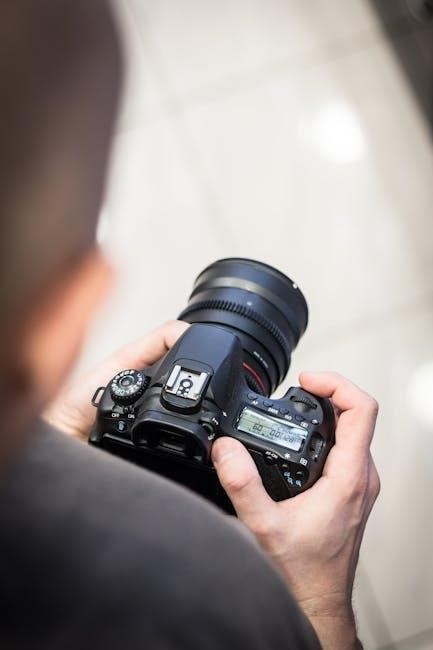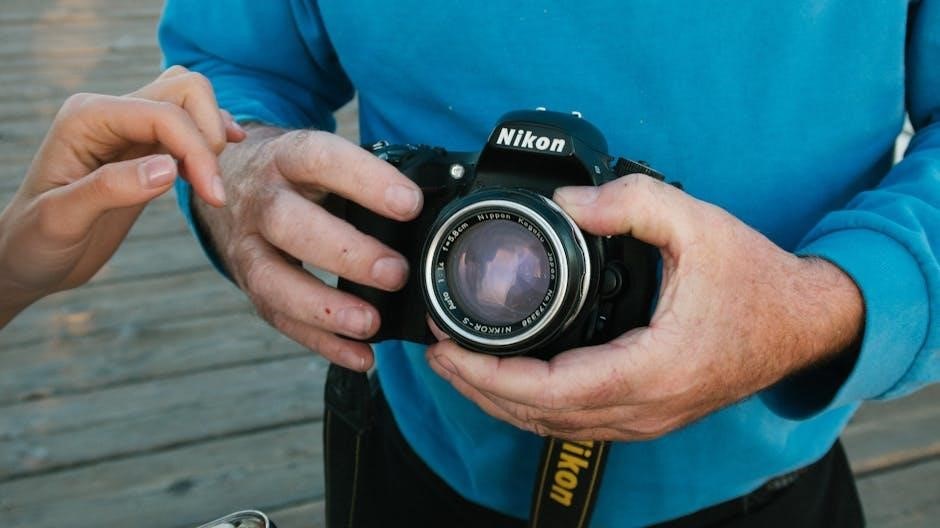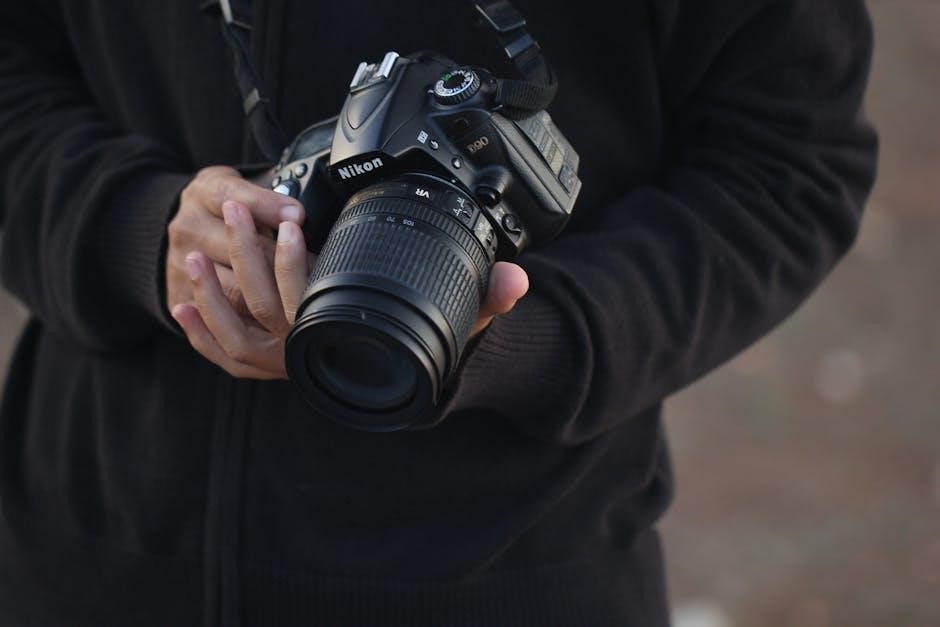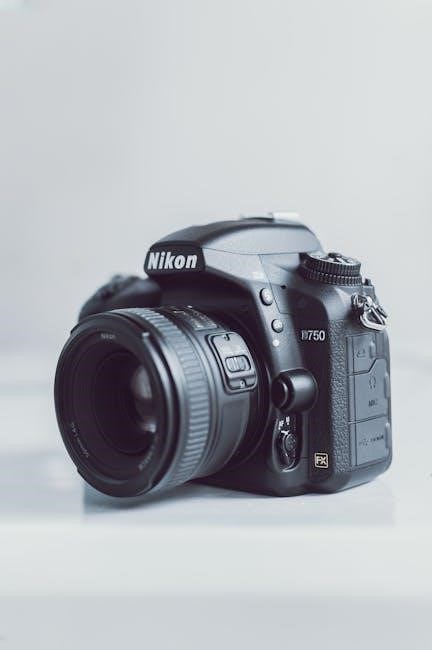The Nikon D3100 is an entry-level DSLR camera designed for photography enthusiasts, offering a 14․2 MP sensor, EXPEED 2 processor, and advanced autofocus system for high-quality images․
1․1 Overview and Target Audience
The Nikon D3100 is an entry-level DSLR camera designed for photography enthusiasts seeking high-quality images and user-friendly features․ It is ideal for beginners and hobbyists looking to transition from compact cameras to a more advanced system․ With its 14․2 MP sensor, EXPEED 2 processor, and 11-point autofocus, the D3100 delivers sharp, vibrant photos․ The camera’s intuitive interface and guide mode make it accessible for new users while offering enough flexibility for creative control․ The manual serves as a comprehensive guide to unlocking its full potential, ensuring users can master both basic and advanced photography techniques․
1․2 Importance of the Manual
The Nikon D3100 manual is crucial for maximizing the camera’s potential, providing detailed instructions for operations, features, and troubleshooting․ It offers a comprehensive guide to understanding the camera’s functions, from basic settings to advanced modes․ The manual ensures users can navigate the menu system, customize settings, and resolve common issues efficiently․ By following the manual, photographers can enhance their skills and produce high-quality images consistently․ It serves as an essential resource for both beginners and experienced users, covering technical specifications and practical tips for optimal camera performance․

Key Features and Specifications
The Nikon D3100 features a 14․2 MP DX-format APS-C sensor, EXPEED 2 image processor, and an 11-point autofocus system for sharp, vibrant images and HD video recording․
2․1 Camera Overview
The Nikon D3100 is a compact and lightweight entry-level DSLR camera designed for photography enthusiasts․ It features a 14․2-megapixel DX-format APS-C sensor, delivering crisp and vibrant images․ Equipped with the EXPEED 2 image processor, it enhances image quality and performance․ The camera offers an 11-point autofocus system for quick and precise focus acquisition․ With an ISO range of 100-12,800, it performs well in various lighting conditions․ Additionally, it supports 1080p HD video recording and features a 3-inch LCD screen for easy composition and playback․
2․2 Technical Specifications
The Nikon D3100 features a 14․2-megapixel DX-format APS-C CMOS sensor and the EXPEED 2 image processor, ensuring high-quality images with vivid colors․ It offers an ISO range of 100-12,800 and supports continuous shooting at 3 frames per second․ The camera has an 11-point autofocus system and a 3-inch LCD screen with 230,400 dots․ Video recording is available in 1080p HD with mono sound․ It uses SD, SDHC, and SDXC memory cards and is compatible with Nikon F-mount lenses․ The camera weighs approximately 455 grams, making it portable for everyday use․
2․3 Unique Selling Points
The Nikon D3100 stands out with its Guide Mode, offering step-by-step assistance for beginners․ Its 14․2 MP sensor and EXPEED 2 processor deliver sharp, vibrant images․ The camera supports Full HD video recording and has a lightweight, ergonomic design․ The 11-point autofocus system ensures precise and fast subject tracking, while the wide ISO range enhances low-light performance․ These features make it an ideal choice for entry-level photographers seeking quality and ease of use in a compact DSLR body․
Getting Started with Your Camera
Unbox and familiarize yourself with the camera, lens, battery, charger, and straps․ Charge the battery fully before first use and mount the lens carefully․ Handle the camera gently, ensuring a firm grip and proper strap adjustment for stability․
3․1 Unboxing and Initial Setup
Unbox your Nikon D3100 carefully, ensuring all components are included, such as the camera body, lens, battery, charger, and straps․ Before first use, charge the battery fully using the provided charger․ Mount the lens by aligning the white dots on the camera and lens, then twist gently to secure․ Handle the camera with care to avoid damage․ Familiarize yourself with the camera’s controls and ensure the strap is properly adjusted for comfortable use․ Refer to the manual for detailed setup instructions to ensure optimal performance․
3․2 Charging the Battery and Mounting the Lens
Charge the EN-EL12 battery using the supplied MH-24 charger until the indicator turns green․ Avoid overcharging to maintain battery health․ To mount the lens, align the white dots on the camera and lens, then twist clockwise until it clicks securely․ Ensure the lens is fully locked to prevent damage․ Always use Nikon-approved lenses for compatibility and optimal performance․ After mounting, power on the camera to initialize the system․ A fully charged battery ensures uninterrupted use during initial setup and photography sessions․
3․3 Basic Camera Handling
Hold the camera firmly with the right hand, supporting the lens with the left for stability․ Use the grip to ensure a secure hold, reducing camera shake․ Access modes via the top dial, and navigate settings through the menu system using the multi-selector․ Use the viewfinder for precise composition and focus․ Familiarize yourself with essential buttons like the shutter release, playback, and delete․ Always handle the camera with care to prevent damage․ Proper handling enhances comfort and ensures optimal performance during photography sessions․

Basic Photography Modes
The Nikon D3100 offers automatic mode, scene modes, and tips for better photos, simplifying photography for beginners while delivering high-quality results in various shooting conditions․
4․1 Automatic Mode
The Automatic Mode on the Nikon D3100 simplifies photography by adjusting exposure, ISO, and autofocus settings for optimal results․ It is ideal for beginners, as it eliminates the need for manual adjustments, allowing users to focus solely on composition․ The camera automatically selects settings based on scene recognition, ensuring well-balanced images in various lighting conditions․ This mode is perfect for everyday shooting, offering convenience and high-quality output without requiring advanced technical knowledge․ However, it lacks manual overrides, making it less suitable for creative control․
4․2 Scene Modes
The Nikon D3100 offers various Scene Modes tailored for specific shooting situations, such as Portrait, Landscape, Close-up, Sports, and Night Portrait․ These modes automatically optimize camera settings like aperture, shutter speed, and ISO to capture the best results for each scenario․ Portrait mode softens backgrounds, while Landscape mode emphasizes sharpness and vibrant colors․ Close-up mode enhances details in small subjects, and Sports mode freezes fast-moving objects․ Night Portrait mode balances flash and ambient light for low-light portraits․ These modes simplify photography, allowing users to achieve professional-looking results without manual adjustments, though they offer less creative control compared to manual modes․
4․4 Tips for Better Photos
To enhance your photography with the Nikon D3100, consider these tips: Use the Rule of Thirds for balanced composition, experiment with angles, and adjust white balance for accurate colors․ Utilize external flash for better lighting in low-light conditions and review images on the LCD to identify improvements․ Shoot in RAW format for greater post-processing flexibility and experiment with Scene Modes for tailored results․ Finally, practice regularly and explore the camera’s features to unlock its full potential for capturing stunning images consistently․

Advanced Shooting Modes
The Nikon D3100 offers advanced shooting modes like Program Auto, Shutter-Priority, Aperture-Priority, and Manual, providing creative control and flexibility for experienced photographers to achieve professional results․
5․1 Program Auto Mode
In Program Auto Mode, the Nikon D3100 balances aperture and shutter speed for optimal results, allowing users to adjust settings like ISO and white balance while the camera manages exposure․ This mode is ideal for transitioning from automatic to manual photography, offering creative flexibility while maintaining ease of use․ It also supports advanced features like Scene Auto Selector, which automatically adjusts settings based on the subject, and AF-F focus mode for continuous autofocus during live view shooting․ With its 14․2 MP sensor and EXPEED 2 processor, Program Auto Mode delivers sharp, vibrant images effortlessly․
5․2 Shutter-Priority Auto Mode
In Shutter-Priority Auto Mode, users can manually set the shutter speed while the camera automatically adjusts the aperture for proper exposure․ This mode is ideal for controlling motion effects, such as freezing fast-moving subjects or creating motion blur․ The D3100 allows shutter speeds from 1/4000th of a second to 30 seconds, plus bulb mode for extended exposures․ It’s perfect for sports, wildlife, or low-light photography, offering creative control while maintaining ease of use․ The 14․2 MP sensor and EXPEED 2 processor ensure sharp, vibrant results in various lighting conditions․
5․3 Aperture-Priority Auto Mode
In Aperture-Priority Auto Mode, users manually set the aperture, while the camera automatically adjusts the shutter speed for optimal exposure․ This mode offers creative control over depth of field, allowing photographers to isolate subjects or ensure sharpness across the frame․ The D3100 supports a wide range of aperture values, making it ideal for portraits, landscapes, and macro photography․ The EXPEED 2 processor ensures balanced exposures, even in challenging lighting conditions, while the 14․2 MP sensor delivers detailed, high-quality images with precise control over blur effects․
5․4 Manual Mode
Manual Mode (M) on the Nikon D3100 allows full control over both aperture and shutter speed, enabling photographers to customize exposures precisely․ This mode is ideal for experienced users or those learning photography fundamentals, as it requires manual adjustment of settings to achieve the desired effect․ The camera’s 14․2 MP sensor and EXPEED 2 processor ensure high-quality results, while the intuitive controls make it easier to experiment with creative techniques․ Manual Mode is perfect for mastering exposure, depth of field, and motion control, offering unparalleled creative freedom for photographers of all skill levels․

Using Live View
Live View activates via the dedicated LV button, enabling preview of shots on the LCD screen․ It supports various focus modes, enhancing framing and composition accuracy for precise results․
6․1 Activating Live View
To activate Live View on the Nikon D3100, press the LV button located on the back of the camera․ This switches the display from the optical viewfinder to the LCD screen, allowing real-time preview of your shot․ Ensure the camera is in Live View mode for video recording or still photography․ The LCD screen will display framing guidelines and focus points, aiding in precise composition․ Use the i button to adjust settings like AF mode for optimal results․
6․2 Focus Modes in Live View
In Live View, the Nikon D3100 offers multiple focus modes to suit different shooting scenarios․ AF-A (Auto-Servo AF) automatically selects between AF-S and AF-C based on subject movement․ AF-S (Single-Servo AF) is ideal for stationary subjects, focusing quickly and locking onto the target․ AF-C (Continuous-Servo AF) is designed for moving subjects, maintaining focus as they move within the frame․ Additionally, Manual Focus allows precise control by adjusting the lens focus ring․ Press the i button to cycle through these modes and ensure sharp focus in your shots․

Recording Movies
The Nikon D3100 allows you to capture high-quality HD movies with ease․ It supports 1080p resolution at 24fps, ensuring smooth and cinematic video recording capabilities for users․
7․1 Starting Movie Recording
To begin recording movies on your Nikon D3100, switch to Live View mode by pressing the LV button․ Use the ‘i’ button to access movie settings, where you can select resolution (1080p, 720p, or 480p) and frame rate (24fps, 30fps, or 25fps)․ Once settings are adjusted, press the red record button to start filming․ You can also use the Shutter Release Button to begin recording quickly․ The camera will stop recording when you press the red button again or when the maximum file size (4GB) is reached․ Ensure the camera is steady for smooth footage and consider using an external microphone for better audio quality․ Always format the memory card before recording for optimal performance․
7․2 Movie Settings and Quality
The Nikon D3100 offers customizable movie settings to enhance video quality․ Choose from resolutions like 1080p, 720p, or 480p, and frame rates such as 24fps, 30fps, or 25fps․ Selecting lower resolutions allows for longer recording sessions․ Use the AF-F mode for continuous autofocus during filming․ For better audio, enable the built-in microphone or connect an external microphone via the 3․5mm jack․ Adjusting White Balance and Picture Controls can refine the visual tone․ Ensure the memory card is formatted to prevent file size limitations and maintain smooth recording performance․
7․4 Tips for Better Video
For high-quality video, stabilize the camera using a tripod to minimize shake․ Use external microphones for clearer audio and manually focus to avoid autofocus noise․ Shoot in manual mode to control exposure settings․ Adjust frame rates and resolution based on the scene․ Ensure proper lighting to enhance colors and contrast․ Avoid overexposure by using the histogram․ Record in short clips to manage file sizes․ Enable continuous autofocus (AF-F) for moving subjects․ Monitor audio levels and use wind reduction if needed․ Regularly clean the lens and sensor for optimal results․

Playback and Editing
The Nikon D3100 allows you to review images, delete unwanted photos, and perform basic editing like trimming clips․ Use the Retouch Menu for enhancements and adjustments․
8;1 Reviewing Images
The Nikon D3100 allows you to review images on its 3-inch LCD screen․ Use the Playback button to view photos, and navigate using the multi-selector․ You can delete unwanted images, zoom in for details, or view thumbnails․ The camera also offers options like slideshow and calendar view․ Use the Retouch Menu for basic edits like trimming, filtering, or adjusting brightness․ These features make it easy to manage and enhance your photos directly on the camera without a computer․
8․2 Basic In-Camera Editing
The Nikon D3100’s Retouch Menu offers basic editing tools to enhance your photos without a computer․ Options include trimming images, applying filters like black-and-white or sepia tones, and adjusting brightness or contrast․ These tools allow for quick and easy enhancements to improve your photos․ The Retouch Menu is user-friendly, making it ideal for beginners to refine their images directly on the camera, ensuring polished results before sharing or transferring to a computer․

Navigating the Menu System
The Nikon D3100’s menu system is divided into Shooting, Playback, Setup, and Retouch Menus, providing easy access to camera settings and editing options for enhanced control․
9․1 Shooting Menu
The Shooting Menu on the Nikon D3100 allows users to adjust settings like image quality, white balance, and ISO sensitivity; It also offers options for autofocus modes, metering, and burst shooting․ Additionally, users can access features such as Active D-Lighting for enhanced dynamic range and noise reduction settings․ Customizing these parameters ensures optimal performance in various shooting conditions, making it easier to achieve desired results․ This menu is essential for photographers seeking precise control over their camera’s functionality․
9․2 Playback Menu
The Playback Menu on the Nikon D3100 provides options for reviewing and managing images․ Users can delete unwanted photos, create slide shows, and rotate images․ Additionally, the menu offers features like protecting files to prevent accidental deletion and displaying histogram data for exposure analysis․ These tools enhance post-capture workflow, allowing photographers to organize and review their work efficiently directly on the camera․ The Playback Menu is a convenient way to manage and enhance your photography experience without transferring files to a computer․
9․3 Setup Menu
The Setup Menu on the Nikon D3100 allows users to customize camera settings for personalized use․ Options include formatting memory cards, setting the camera’s language, and adjusting monitor brightness․ Additionally, users can enable or disable features like auto image rotation and HDMI output settings․ These settings enhance the camera’s functionality and user experience, ensuring it operates according to individual preferences․ The Setup Menu provides essential tools for tailoring the camera to meet specific needs without altering shooting parameters․
9․4 Retouch Menu
The Retouch Menu on the Nikon D3100 offers a variety of in-camera editing options to enhance or correct images without using external software․ Features include D-Lighting to adjust brightness and contrast, Red-eye correction, and Trim for cropping images․ Users can also convert photos to monochrome or adjust color balance․ Additional options like Distortion Control and Fisheye help correct lens-related distortions․ These tools provide convenience for making quick adjustments to photos directly on the camera, ensuring improved image quality and artistic control․
Customizing Your Camera
Customize the Nikon D3100 to suit your preferences by adjusting settings like autofocus, metering modes, and button assignments for enhanced control and personalized shooting experiences․
10․1 Custom Settings
Custom settings on the Nikon D3100 allow users to tailor camera functions to their preferences․ Adjustments can be made to autofocus modes, metering options, and exposure compensation․ Users can also customize button assignments for quicker access to frequently used features․ These settings are accessed through the camera’s menu system, enabling photographers to streamline their workflow and enhance creativity․ By personalizing these options, users can optimize the camera’s performance for their specific needs, ensuring a more intuitive and efficient shooting experience․
10․2 Personalizing Camera Settings
Personalizing camera settings on the Nikon D3100 allows users to tailor the camera to their shooting style․ The camera offers options to save custom settings, ensuring consistency across shoots․ Users can adjust and store preferences for autofocus, metering modes, and exposure settings․ Additionally, custom profiles can be created for different shooting scenarios, such as portraits or landscapes․ This feature enhances workflow efficiency and ensures that the camera is optimized for individual preferences, making it easier to achieve desired results in various photography situations․

Troubleshooting Common Issues
This section covers common issues and solutions for the Nikon D3100, including error messages, lens problems, and battery life, ensuring smooth camera operation․
11․1 Common Errors and Solutions
The Nikon D3100 may display error messages like “ERR” or “CARD NOT INITIALIZED․” These often indicate issues with memory cards or improper settings․ To resolve, format the memory card in the camera or check card compatibility․ Lens errors, such as “F–” or “FEE,” may require cleaning the lens contacts or re-mounting the lens properly․ Battery issues, like low power warnings, can be addressed by charging the battery or ensuring it is properly inserted․ Refer to the troubleshooting guide for detailed solutions to restore functionality․
11․2 Resetting the Camera
To reset the Nikon D3100, press and hold the reset button near the battery compartment while inserting the battery․ This resets shooting settings to default․ Alternatively, use the menu system: go to the Setup Menu, select “Reset,” and choose “Reset” or “Reset to Default Settings․” Note that resetting may erase custom settings, so ensure settings are saved before proceeding․ This feature is useful for troubleshooting or preparing the camera for sale․ Always refer to the manual for detailed reset procedures to avoid data loss or unintended changes․ Resetting helps restore optimal camera performance and functionality․ Use this option cautiously and as needed for best results․ Resetting the camera can resolve software glitches and restore factory defaults, ensuring smooth operation․ It is recommended to reset settings when experiencing persistent issues or when transferring ownership․ Resetting the Nikon D3100 is a straightforward process that can be done via the reset button or through the menu system, providing a quick solution to restore default settings and resolve common errors․ Always backup custom settings before performing a reset to avoid losing personalized configurations; Resetting the camera can help maintain its performance and ensure optimal image quality by reverting to factory settings; Use the reset feature wisely to troubleshoot or prepare the camera for a fresh start․ Resetting the Nikon D3100 is a simple yet effective way to resolve software-related issues and restore the camera to its original state, ensuring it functions as intended․ By resetting, users can address errors and start anew with default settings, making it a valuable troubleshooting tool for photographers of all levels․ Resetting the camera is a recommended step when encountering recurring problems or preparing the device for sale, ensuring it operates smoothly for the next user․ Always perform a reset carefully, following the steps outlined in the manual to avoid unintended consequences․ Resetting the Nikon D3100 is a quick and easy process that can help restore its functionality and performance, making it a useful feature for maintaining the camera’s optimal state․ By resetting, users can resolve software glitches, revert to default settings, and ensure the camera operates at its best, providing a reliable solution for photographers․ Resetting the Nikon D3100 is a straightforward process that can be done via the reset button or the menu system, offering a quick fix for common issues and restoring the camera to its factory settings․ This feature is essential for troubleshooting and maintaining the camera’s performance, ensuring it continues to deliver high-quality images․ Resetting the camera is a simple yet effective way to address errors and restore default settings, providing a fresh start for photographers․ Always refer to the manual for detailed instructions on how to reset the Nikon D3100 properly, ensuring the process is done correctly and safely․ Resetting the camera can help resolve software-related problems and restore its functionality, making it a valuable tool for maintaining the Nikon D3100’s performance and image quality․ By resetting the camera, users can address common issues and revert to factory settings, ensuring the device operates smoothly and efficiently․ Resetting the Nikon D3100 is a quick and easy process that can help restore its functionality and performance, providing a reliable solution for photographers․ Always backup custom settings before resetting to avoid losing personalized configurations․ Resetting the camera is a recommended step when encountering persistent issues or when transferring ownership, ensuring it operates at its best for the next user․ By resetting the Nikon D3100, users can resolve software glitches and restore default settings, providing a fresh start and ensuring optimal performance․ Resetting the camera is a simple yet effective way to troubleshoot common errors and maintain its functionality, making it a useful feature for photographers of all levels․ Always perform a reset carefully, following the steps outlined in the manual to avoid unintended consequences․ Resetting the Nikon D3100 is a quick and easy process that can help restore its functionality and performance, ensuring it continues to deliver high-quality images․ By resetting, users can address software-related issues and revert to factory settings, providing a reliable solution for maintaining the camera’s optimal state․ Resetting the Nikon D3100 is a straightforward process that can be done via the reset button or through the menu system, offering a quick fix for common problems and restoring the camera to its original state․ This feature is essential for troubleshooting and ensuring the camera operates at its best, delivering exceptional image quality․ Resetting the camera is a simple yet effective way to address errors and restore default settings, providing a fresh start for photographers․ Always refer to the manual for detailed instructions on how to reset the Nikon D3100 properly, ensuring the process is done correctly and safely․ Resetting the camera can help resolve software-related problems and restore its functionality, making it a valuable tool for maintaining the Nikon D3100’s performance and image quality․ By resetting the camera, users can address common issues and revert to factory settings, ensuring the device operates smoothly and efficiently․ Resetting the Nikon D3100 is a quick and easy process that can help restore its functionality and performance, providing a reliable solution for photographers․ Always backup custom settings before resetting to avoid losing personalized configurations․ Resetting the camera is a recommended step when encountering persistent issues or when transferring ownership, ensuring it operates at its best for the next user․ By resetting the Nikon D3100, users can resolve software glitches and restore default settings, providing a fresh start and ensuring optimal performance․ Resetting the camera is a simple yet effective way to troubleshoot common errors and maintain its functionality, making it a useful feature for photographers of all levels․ Always perform a reset carefully, following the steps outlined in the manual to avoid unintended consequences․ Resetting the Nikon D3100 is a quick and easy process that can help restore its functionality and performance, ensuring it continues to deliver high-quality images․ By resetting, users can address software-related issues and revert to factory settings, providing a reliable solution for maintaining the camera’s optimal state․ Resetting the Nikon D3100 is a straightforward process that can be done via the reset button or through the menu system, offering a quick fix for common problems and restoring the camera to its original state․ This feature is essential for troubleshooting and ensuring the camera operates at its best, delivering exceptional image quality․ Resetting the camera is a simple yet effective way to address errors and restore default settings, providing a fresh start for photographers․ Always refer to the manual for detailed instructions on how to reset the Nikon D3100 properly, ensuring the process is done correctly and safely․ Resetting the camera can help resolve software-related problems and restore its functionality, making it a valuable tool for maintaining the Nikon D3100’s performance and image quality․ By resetting the camera, users can address common issues and revert to factory settings, ensuring the device operates smoothly and efficiently․ Resetting the Nikon D3100 is a quick and easy process that can help restore its functionality and performance, providing a reliable solution for photographers․ Always backup custom settings before resetting to avoid losing personalized configurations․ Resetting the camera is a recommended step when encountering persistent issues or when transferring ownership, ensuring it operates at its best for the next user․ By resetting the Nikon D3100, users can resolve software glitches and restore default settings, providing a fresh start and ensuring optimal performance․ Resetting the camera is a simple yet effective way to troubleshoot common errors and maintain its functionality, making it a useful feature for photographers of all levels․ Always perform a reset carefully, following the steps outlined in the manual to avoid unintended consequences․ Resetting the Nikon D3100 is a quick and easy process that can help restore its functionality and performance, ensuring it continues to deliver high-quality images․ By resetting, users can address software-related issues and revert to factory settings, providing a reliable solution for maintaining the camera’s optimal state․ Resetting the Nikon D3100 is a straightforward process that can be done via the reset button or through the menu system, offering a quick fix for common problems and restoring the camera to its original state․ This feature is essential for troubleshooting and ensuring the camera operates at its best, delivering exceptional image quality․ Resetting the camera is a simple yet effective way to address errors and restore default settings, providing a fresh start for photographers․ Always refer to the manual for detailed instructions on how to reset the Nikon D3100 properly, ensuring the process is done correctly and safely․ Resetting the camera can help resolve software-related problems and restore its functionality, making it a valuable tool for maintaining the Nikon D3100’s performance and image quality․ By resetting the camera, users can address common issues and revert to factory settings, ensuring the device operates smoothly and efficiently․ Resetting the Nikon D3100 is a quick and easy process that can help restore its functionality and performance, providing a reliable solution for photographers․ Always backup custom settings before resetting to avoid losing personalized configurations․ Resetting the camera is a recommended

Firmware Updates and Maintenance
Technical Specifications
The Nikon D3100 features a 14․2 MP DX-format APS-C CMOS sensor, EXPEED 2 image-processing engine, ISO range of 100-12,800, and records HD movies up to 1080p․

